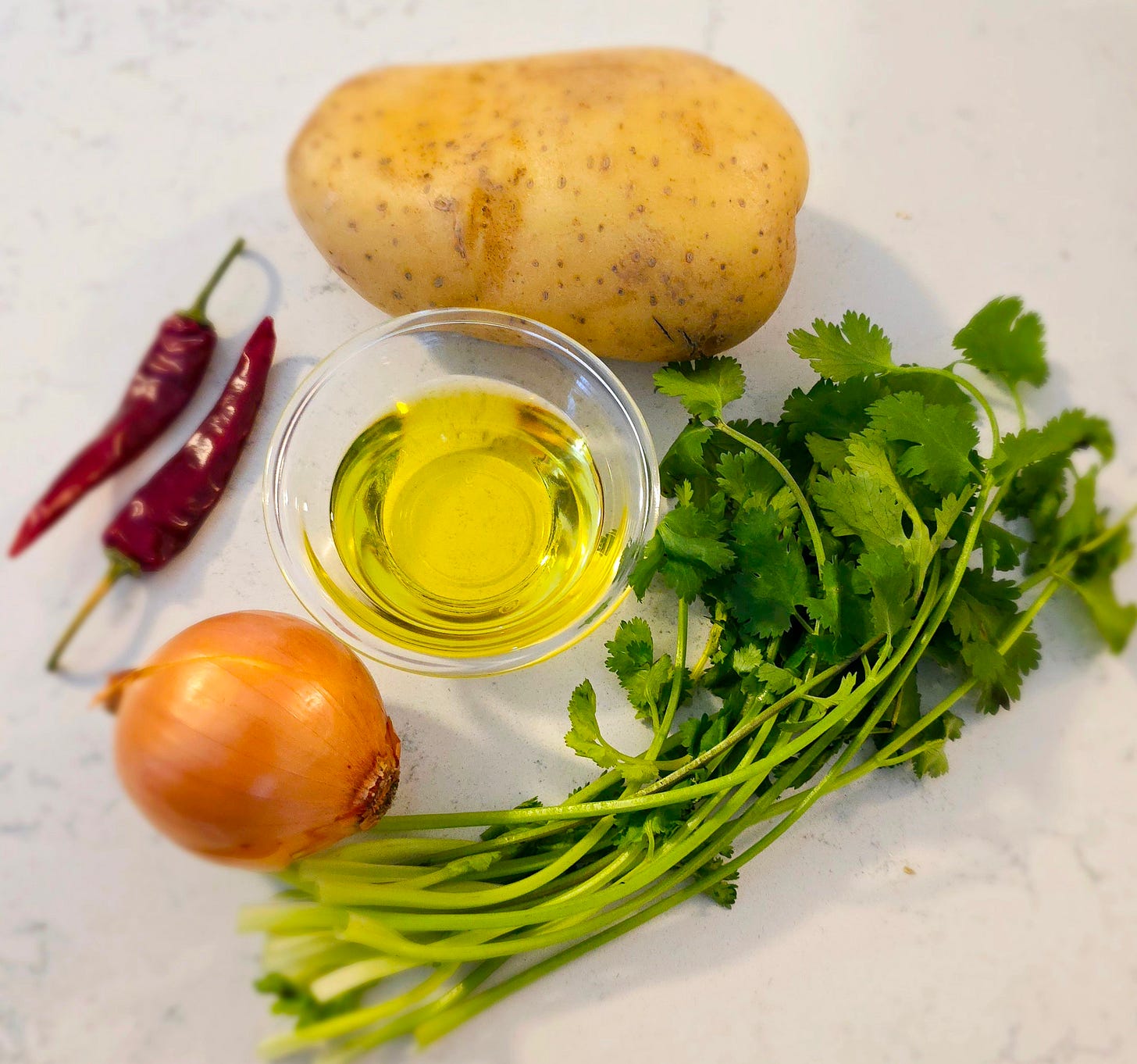If you were to ask a Bangladeshi to name the top three quintessential Bangladeshi foods, the list would very likely include bhat (rice), maach (fish) and bhorta.
Bhortas are the openers to a Bangladeshi meal. They are intended to be spicy, tangy, or fresh palate opening blends that are mixed with steaming hot rice to start the meal.
The simple bhorta is usually a mash-like preparation of vegetables, peels, or leafy greens - but also sometimes fish, seeds, nuts, or even meat - that is combined with fresh or dried chilies, onions, cilantro, salt and mustard oil or ghee. There are hundreds of variations of bhorta, including potato (which we’ll cover today), tomato, beans, bottle gourd peels, eggplant, and more.
The origins of the bhorta are in the rural heartlands of Bangladesh. There is a rich biodiversity in Bangladesh of uncultivated foods (that is, food that grows in the natural environment, without any human intervention). Uncultivated foods constitute nearly 40% of the diet in rural Bangladesh, and among the very poor, the dependence is nearly 100%. So the bhorta plays a key role in the sustenance of a population.
Understanding this cultural disposition to uncultivated foods helps me to understand my mother better. Growing up in the Toronto area, my mother always had a knack for finding familiar leafy greens or fruit bearing trees in unexpected places. She would delight in picking wild pears from our local trail, or crab apples from a neighbour’s tree and bringing them home to make a bhorta or achar out of it. My teenage self (ever conscious of trying to fit in, and what will people think!) would admonish what I thought was peculiar behaviour. But my adult self loves these finds as much as my mother. Now it makes so much sense!

In recent years, the humble bhorta has become a marker of cultural and national identity for Bangladeshis as an indigenous food that crosses urban-rural and rich-poor divides. There are events and festivals that are dedicated to bhortas, restaurants that serve only bhortas, with a rotation of 70 to 100 varieties.
The ultimate comfort food, the bhorta is cheap and easy to make, which makes it a hugely accessible dish for anyone.
The aloo bhorta (potato bhorta) is in my opinion perhaps the most popular bhorta for its sheer simplicity and comfort. This is a staple - when you have nothing else to eat, or you don’t know what to make - aloo bhorta can come to your rescue.
Our Aloo Bhorta recipe is kicking off a series of Bangladeshi Basics which will cover a simple and basic preparation for each part of a Bangladeshi meal. Next week we’ll be covering Bhaji.
Whatever you’re eating this week, moja kore khao (eat with delight, or enjoy your food!)
Mitali
Aloo Bhorta (Potato Bhorta)
Ingredients
1 large potato, or two medium potatoes
¼ cup water
Two dried red chilies
2-3 tablespoons Mustard oil or vegetable oil of your choice.
1 small onion sliced (approx ½ cup sliced)
1 small handful coriander leaves/cilantro chopped (¼ cup chopped)
1 teaspoon salt
Method
Cut potato into quarters, place on a plate or shallow bowl and add ¼ cup water.
Place potato in the microwave and cook on high power for 5 minutes. You should be able to easily pierce the potato with a fork. If not, put it back in the microwave for another minute.
While the potato is in the microwave, fry the dried red chillies on medium high heat on the stove until dark brown. You can use some oil to fry, or use no oil for a dry roast. Remove and set aside.
When the potatoes are done, drain any remaining water. Peel the potatoes, and mash the potatoes using a fork.
In a bowl, start mashing the chillies and combining them with the onion. Add the oil and the salt, and continue to mash and combine with the coriander leaves. Add the potato until thoroughly combined. It is best to use your hand for this task to get the right consistency. Taste for salt, and add more oil if you want a softer bhorta.
When done, form the bhorta into a mound and serve with steaming white rice.
Notes:
Mustard oil can be quite strong, and some don’t like the flavour. You can opt to use any other vegetable oil of your choice, or to use half mustard oil and half vegetable oil.
Variations: you can also make this recipe with fresh green chilies and melted ghee instead of dried red chilies and mustard oil.
If using your hands to mash/mix, beware that chilies can linger on your fingers. Be careful not to touch your eyes or other sensitive areas, and make sure to wash your hands well.






